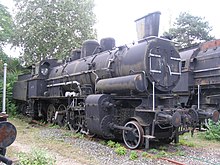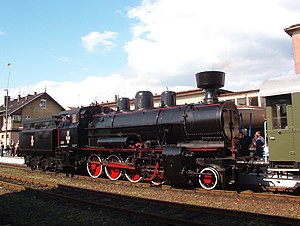kkStB 270
| kkStB 270 BBÖ 270 / ČSD 434.1 / FS 728 / JDŽ 25 / PKP Tr12 / MÁV 403.6 / CFR 140 / DSA 140 ÖBB 156 |
|
|---|---|
|
PKP Tr12-25 with Kobel spark arrester
|
|
| Numbering: | kkStB 270.01–07 ČSD 434.101–1199 |
| Number: | kkStB: 7 ČSD: 165 + 34 (1918 ex kkStB, 1945 ex BBÖ) BBÖ: 100 SHS : 9 CFR: 132 FS: 35 PKP: 142 MÀV: 8 ÖBB: 25 |
| Manufacturer: | Bohemian-Moravian Machine Factory , Breitfeld & Danek , ČKD , Adamov, Škoda , Wiener Neustädter Lokomotivfabrik , Lokomotivfabrik Floridsdorf |
| Year of construction (s): | 1917-1930 |
| Retirement: | ÖBB: until 1968 ČSD: until 1976 |
| Axis formula : | 1'D h2 |
| Length: | 17,443 mm |
| Height: | 4,589 mm |
| Fixed wheelbase: | 2,800 mm |
| Total wheelbase: | 6,800 mm |
| Wheelbase with tender: | 13,712 mm |
| Empty mass: | 61.2 t |
| Service mass: | 68.0 t |
| Friction mass: | 57.3 t |
| Top speed: | 60 km / h |
| Driving wheel diameter: | 1,258 mm |
| Impeller diameter front: | 830 mm |
| Cylinder diameter: | 570 mm |
| Piston stroke: | 632 mm |
| Boiler overpressure: | 13 bar |
| Number of heating pipes: | 173 |
| Number of smoke tubes: | 24 |
| Grate area: | 3.87 m² |
| Radiant heating surface: | 13.90 m² |
| Tubular heating surface: | 169.80 m² |
| Superheater area : | 38.3 m² |
| Tender: | 9 , 56 , 156 , 256 , 76 , 86 , 88 / ČSD 516.0 |
The kkStB 270 was a freight train - Train Locomotive of the Imperial Austrian State Railways .
The 270 series in Austria

20 years passed between the appearance of the 170 series and its superheated steam variant, as the military preferred the simply constructed wet steam engines. It was not until 1915 that Johann Rihosek , Karl Gölsdorf's representative , worked out the design of the superheated steam twin locomotive. The Bohemian-Moravian Machine Factory took over the constructive work . As is customary in Austria, the superheater surface was rather small, as it was feared, rightly, that the domestic lubricating oil would not be able to withstand higher temperatures. The pulling power of the 270s was considerably higher than that of the 170s: it could carry 1220 t at 60 km / h. The two steam domes with connecting pipes from the 170s were replaced by a simple steam dome and two sand domes.
Due to the war, the first 7 locomotives were not delivered by the Bohemian-Moravian Machine Factory until 1917. 27 pieces had been produced by the end of the war. The machines were only built in series for the BBÖ from 1920 , and a total of 100 units were put into service by 1922. The entire inventory was taken over by the Deutsche Reichsbahn in 1938 as 56.3401−3500. After the Second World War, only 25 remained in Austria, which the ÖBB classified as series 156 . Giesl ejectors were installed in 15 locomotives and boiler pipe throttling was applied. The ÖBB decommissioned the last machines in this series in 1968. Only the 156.3423 (ex 270.125) remained.
The 270 series in Czechoslovakia

Part of the 270 series remained in the newly founded Czechoslovakia after the First World War . The Czechoslovak State Railways (ČSD) had another 119 machines built from 1919. While these were initially supplied by the Austrian manufacturers Wiener Neustadt and Floridsdorf , from 1920 almost all Czech locomotive manufacturers were included in the production. From 1924 the locomotives received the new class designation 434.1 . The 434.1165 was the last machine to enter service until 1930. Characteristic of its appearance was its bulbous chimney with the brim, the three domes in the middle of the boiler and its driver's cab.
After the Second World War, 34 former BBÖ locomotives remained in Czechoslovakia, so that their number increased to 199 locomotives. They were mainly used in freight train and shunting services until they were mainly replaced by the T 458.1 series diesel locomotives (today: 721 series). Most locomotives retired from active service by 1972. The last operational machine was the 434.1181, which was retired on March 16, 1976.
434.1100 (the first locomotive manufactured by the Škoda works) was preserved as an operational ČD museum locomotive and 434.1128 in the Žilina depot as a ŽSR museum locomotive .
The 270 series in the other successor states of the monarchy
The Floridsdorf locomotive factory delivered a total of 253 copies of the 270 series to Poland, where they classified the PKP as Tr12 , to Czechoslovakia, Yugoslavia ( JD 25 ), to Italy ( FS 728 ) and to Romania ( CFR 140 ). PKP procured further machines that were delivered to Poland in the form of semi-finished parts from the Wiener Neustädter Lokomotivfabrik . When Czechoslovakia ceded parts of the country to Hungary, machines of the 434.1 series came to MÁV as 403.6 . Romania also ordered other machines of this series from Škoda in Pilsen in Czechoslovakia and from Schneider in le Creusot (France). In addition, the machine factory of the Hungarian State Railways built eight copies for the Danube-Save-Adria-Bahn , the successor to the Southern Railway Company , which it called the 140 series. These machines came to MÁV in 1934 as the 403.5 series.
See also
literature
- Collective of authors: Catalog of historical railway vehicles on Slovak territory , Bratislava, 2001.
- Directory of the locomotives, tenders, water cars and railcars of the kk Austrian State Railways and the state-operated private railways as of June 30, 1917 , 14th edition, published by the kk Austrian State Railways, Vienna, 1918.
- Karl Gölsdorf : Lokomotivbau in Alt-Österreich 1837-1918 , Verlag Slezak, 1978. ISBN 3-900134-40-5 .
- Heribert Schröpfer: Traction vehicles of Austrian railways - steam locomotives BBÖ and ÖBB , alba-Verlag, Düsseldorf, 1989, ISBN 3-87094-110-3 .
- Johann Stockklausner: Steam company in Old Austria , Slezak publishing house, Vienna, 1979, ISBN 3-900134-41-3 .
- Dieter Zoubek: Preserved steam locomotives in and from Austria , self-published, 2004, ISBN 3-200-00174-7 .
- Johann Blieberger, Josef Pospichal: The kkStB traction vehicles, Volume 3. The rows 61 to 380 . bahnmedien.at, 2010, ISBN 978-3-9502648-6-9 .
Web links
- Locomotive statistics Pospichal
- Company photo from the 1960s in Česká Lípa on www.k-report.net

